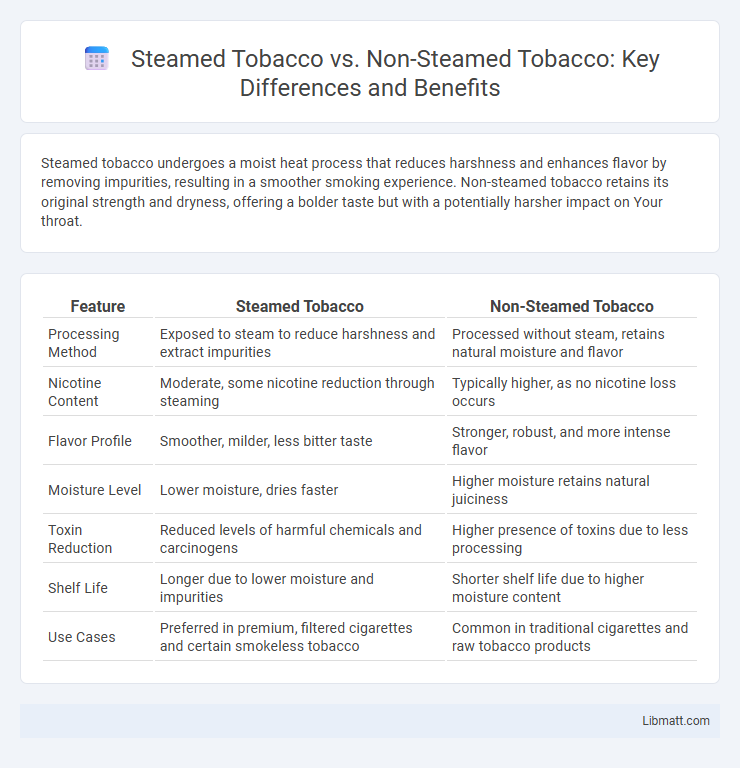Steamed tobacco undergoes a moist heat process that reduces harshness and enhances flavor by removing impurities, resulting in a smoother smoking experience. Non-steamed tobacco retains its original strength and dryness, offering a bolder taste but with a potentially harsher impact on Your throat.
Table of Comparison
| Feature | Steamed Tobacco | Non-Steamed Tobacco |
|---|---|---|
| Processing Method | Exposed to steam to reduce harshness and extract impurities | Processed without steam, retains natural moisture and flavor |
| Nicotine Content | Moderate, some nicotine reduction through steaming | Typically higher, as no nicotine loss occurs |
| Flavor Profile | Smoother, milder, less bitter taste | Stronger, robust, and more intense flavor |
| Moisture Level | Lower moisture, dries faster | Higher moisture retains natural juiciness |
| Toxin Reduction | Reduced levels of harmful chemicals and carcinogens | Higher presence of toxins due to less processing |
| Shelf Life | Longer due to lower moisture and impurities | Shorter shelf life due to higher moisture content |
| Use Cases | Preferred in premium, filtered cigarettes and certain smokeless tobacco | Common in traditional cigarettes and raw tobacco products |
Introduction to Steamed vs Non-Steamed Tobacco
Steamed tobacco undergoes a moist heat process that reduces harmful chemicals and enhances its natural flavor, distinguishing it from non-steamed tobacco which retains a stronger, harsher taste due to lack of steam treatment. The steaming process affects nicotine absorption and can influence the overall smoothness and aroma, making steamed tobacco often preferred by users seeking a milder experience. Understanding these differences can help you select the tobacco type that best suits your preferences and health considerations.
Historical Background of Tobacco Processing
Steamed tobacco, developed in the early 20th century, was introduced to reduce harmful chemicals and preserve flavor through a moist heat process, contrasting with traditional non-steamed tobacco that undergoes dry curing and fermentation. Historical records show non-steamed tobacco has been used for centuries, relying on air or sun curing methods that enhance nicotine concentration but produce harsher smoke. Understanding your tobacco processing options highlights how steaming influences chemical composition and smoking experience compared to conventional non-steamed varieties.
What Is Steamed Tobacco?
Steamed tobacco is tobacco that has undergone a moist heat treatment process, which reduces harmful substances and enhances flavor by softening the leaves and releasing natural oils. Unlike non-steamed tobacco, which is dried and cured without this additional step, steamed tobacco offers a smoother and more refined smoking experience with potentially fewer toxins. You can notice that steamed tobacco maintains a richer aroma and improved combustibility due to its unique preparation method.
What Is Non-Steamed Tobacco?
Non-steamed tobacco refers to tobacco leaves that have not undergone the steaming process, preserving their original moisture content, flavor profile, and chemical composition. This type of tobacco often maintains higher levels of ammonia and nicotine compared to steamed variants, resulting in a harsher taste and stronger nicotine impact. Non-steamed tobacco is commonly preferred in traditional smoking products where a robust and intense smoking experience is desired.
Key Differences in Processing Methods
Steamed tobacco undergoes a high-temperature steam treatment that alters its chemical composition, resulting in reduced acidity and a smoother flavor profile compared to non-steamed tobacco. Non-steamed tobacco retains its natural curing characteristics but often exhibits stronger, harsher notes due to the lack of steam exposure. Understanding these processing differences can help you choose tobacco that aligns with your taste preferences and smoking experience.
Flavor Profiles: Steamed vs Non-Steamed
Steamed tobacco exhibits a smoother, milder flavor profile with reduced harshness and enhanced natural sweetness, often leading to a more aromatic smoking experience. Non-steamed tobacco typically retains stronger, bolder flavors with intensified smokiness and earthier tones due to less processing. The steaming process alters the chemical compounds in tobacco leaves, which directly impacts nicotine delivery and flavor complexities, making steamed tobacco preferred for those seeking refined taste nuances.
Health Implications of Steaming Tobacco
Steamed tobacco produces fewer harmful chemicals like tar and carbon monoxide compared to non-steamed tobacco, potentially reducing exposure to toxic substances. This process lowers the risk of respiratory issues and cardiovascular diseases associated with smoking, though it does not eliminate all health risks. Research indicates that steaming may decrease the presence of carcinogens, but long-term health effects require further investigation.
Market Trends and Consumer Preferences
Steamed tobacco is gaining traction in the market due to growing consumer demand for less harsh and smoother smoking experiences, appealing particularly to health-conscious users seeking reduced chemical exposure. Non-steamed tobacco remains popular because of its traditional flavor profile and stronger nicotine delivery, attracting long-time smokers who prefer authenticity. Your choice may depend on whether you prioritize innovation and health-oriented trends or the classic tobacco taste that dominates the current market landscape.
Popular Products and Brands in Each Category
Popular steamed tobacco products include brands like Swisher Sweets and Backwoods, known for their moist texture and smoother smoking experience. Non-steamed tobacco is often represented by traditional brands such as Marlboro and Camel, which are favored for their dry, robust flavor profiles. Consumers choose steamed options for a milder taste, while non-steamed varieties appeal to those seeking stronger tobacco intensity.
Conclusion: Choosing Between Steamed and Non-Steamed Tobacco
Steamed tobacco offers a smoother, milder flavor profile with reduced harshness and lower levels of certain harmful compounds compared to non-steamed tobacco, making it a preferred choice for smokers seeking a less intense experience. Non-steamed tobacco retains stronger flavors and a more robust nicotine delivery, appealing to those who favor traditional tobacco taste and potency. Ultimately, the choice between steamed and non-steamed tobacco depends on individual preferences regarding flavor, strength, and health considerations.
Steamed tobacco vs non-steamed Infographic

 libmatt.com
libmatt.com